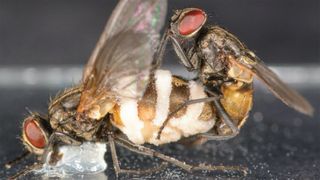Mind-controlling fungus makes male flies mate with dead, infected females
The fungus attracts males with an irresistible come-hither chemical cocktail.

A deadly fungus infects and controls the minds of house flies, before consuming them from the inside out — and that's just the start of its gruesome reproductive strategy. As the fungus's grand finale, its spores, which poke from the cadavers of infected female flies, emit an alluring scent that seduces males into mating with the corpses.
When the pathogenic fungus Entomophthora muscae infects house flies (Musca domestica), it begins by manipulating their behavior, compelling the flies to climb to an elevated surface, like a tall plant stem or twig. The zombie flies then cling and die there with their wings outstretched, in order to better disperse the fungal spores that sprouted from their bodies.
But for female flies, the horror doesn't end with their deaths. The fungus also emits chemicals resembling those produced by females when they're ready to mate. That sexy scent is thought to be extremely potent, because it attracts healthy males and prompts them to mount the dead females; the males in turn become infected and fly off to spread the fungal spores among their friends and neighbors.
Related: Microscopic worlds gallery: Fascinating fungi
Scientists who study this fungus and its effect on house fly hosts were previously surprised to see that healthy male flies in the laboratory were unusually interested in mating with dead, infected females, said Andreas Naundrup Hansen, a microbiology researcher at the University of Copenhagen and lead author of a new study on this previously unknown aspect of the fungal infection.
"We were very curious about this odd behavior, as it obviously seemed dangerous to the copulating male to have intimate contact with cadavers that were actively discharging infectious conidia (spores)," Hansen told Live Science in an email.
Fungal spores infect house flies by hitchhiking on a fly's exoskeleton, germinating and then breaking through the fly's tough outer cuticle. "The fungus then starts growing inside the hemocoel — the bloodstream — of the fly," absorbing nutrients from the fly's body as it grows, Hansen said. The infected fly dies about five to eight days later, and spores emerge from the dead insect approximately two hours after death.
Sign up for the Live Science daily newsletter now
Get the world’s most fascinating discoveries delivered straight to your inbox.
When the researchers tempted male flies with an assortment of female cadavers — some that were infected with the fungus and some that weren't — they found that the males more often tried to mate with infected corpses, suggesting that something related to the fungus made these particular cadavers more alluring. Analysis of chemical signatures produced by the dead females revealed a blend of several compounds that males would find irresistible, according to the study.
Simply irresistible
Two of the compounds found in the aromas of these dead flies were ethyl octanoate and a group of chemicals known as sesquiterpenes, both of which are known for their insect-luring abilities. Though spores emerged from the females' bodies just a few hours after the insects died, the corpses were at their most attractive to males during the later stages of spore production: approximately 25 to 30 hours after death.
Other species of pathogenic fungi also use chemicals to alter the behavior of their insect hosts. Fungi from the genus Massospora infuse the nervous systems of cicadas with mind-altering psilocin and cathinone — the active compounds in hallucinogenic mushrooms — turning cicadas into sex-crazed zombies that spread the pathogen as they mate with as many partners as possible, Live Science previously reported.
Another mind-bending example, the fungus Ophiocordyceps unilateralis, infects carpenter ants in the genus Camponotus using two compounds, guanidinobutyric acid and sphingosine, which are also thought to affect behavior, Hansen said. Once this fungus takes control of an ant's brain and nervous system, it leads the ant on a death march up a plant stem or to the top of a shrub or bush. There, the insect clamps its mandibles into the plant and hangs on until it dies; the fungus then releases its spores to infect more ants.
One possible explanation for E. muscae's combination of behavior manipulation and sexual mimicry is that attracting male house fly hosts could be especially important for the fungus because it's a species-specific pathogen that infects only house flies, the researchers suggested.
"When the access to new hosts are limited, it's crucial for the fungus to ensure transmission to new suitable hosts of the right species," Hansen said.
The findings were published Oct. 22 on the preprint server bioRxiv and have not been peer reviewed.
Originally published on Live Science.

Mindy Weisberger is an editor at Scholastic and a former Live Science channel editor and senior writer. She has reported on general science, covering climate change, paleontology, biology, and space. Mindy studied film at Columbia University; prior to Live Science she produced, wrote and directed media for the American Museum of Natural History in New York City. Her videos about dinosaurs, astrophysics, biodiversity and evolution appear in museums and science centers worldwide, earning awards such as the CINE Golden Eagle and the Communicator Award of Excellence. Her writing has also appeared in Scientific American, The Washington Post and How It Works Magazine.
